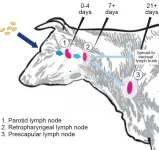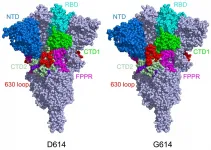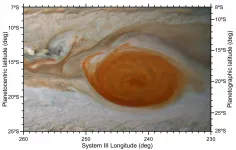INFORMATION:
Written by Jennifer Chu, MIT News Office
Ultrasound has potential to damage coronaviruses, study finds
Simulations show ultrasound waves at medical imaging frequencies can cause the virus' shell and spikes to collapse and rupture
2021-03-17
(Press-News.org) The coronavirus' structure is an all-too-familiar image, with its densely packed surface receptors resembling a thorny crown. These spike-like proteins latch onto healthy cells and trigger the invasion of viral RNA. While the virus' geometry and infection strategy is generally understood, little is known about its physical integrity.
A new study by researchers in MIT's Department of Mechanical Engineering suggests that coronaviruses may be vulnerable to ultrasound vibrations, within the frequencies used in medical diagnostic imaging.
Through computer simulations, the team has modeled the virus' mechanical response to vibrations across a range of ultrasound frequencies. They found that vibrations between 25 and 100 megahertz triggered the virus' shell and spikes to collapse and start to rupture within a fraction of a millisecond. This effect was seen in simulations of the virus in air and in water.
The results are preliminary, and based on limited data regarding the virus' physical properties. Nevertheless, the researchers say their findings are a first hint at a possible ultrasound-based treatment for coronaviruses, including the novel SARS-CoV-2 virus. How exactly ultrasound could be administered, and how effective it would be in damaging the virus within the complexity of the human body, are among the major questions scientists will have to tackle going forward.
"We've proven that under ultrasound excitation the coronavirus shell and spikes will vibrate, and the amplitude of that vibration will be very large, producing strains that could break certain parts of the virus, doing visible damage to the outer shell and possibly invisible damage to the RNA inside," says Tomasz Wierzbicki, professor of applied mechanics at MIT. "The hope is that our paper will initiate a discussion across various disciplines."
The team's results appear online in the Journal of the Mechanics and Physics of Solids. Wierzbicki's co-authors are Wei Li, Yuming Liu, and Juner Zhu at MIT.
A spiky shell
As the Covid-19 pandemic took hold around the world, Wierzbicki looked to contribute to the scientific understanding of the virus. His group's focus is in solid and structural mechanics, and the study of how materials fracture under various stresses and strains. With this perspective, he wondered what could be learned about the virus' fracture potential.
Wierzbicki's team set out to simulate the novel coronavirus and its mechanical response to vibrations. They used simple concepts of the mechanics and physics of solids to construct a geometrical and computational model of the virus' structure, which they based on limited information in the scientific literature, such as microscopic images of the virus' shell and spikes.
From previous studies, scientists have mapped out the general structure of the coronavirus -- a family of viruses that s HIV, influenza, and the novel SARS-CoV-2 strain. This structure consists of a smooth shell of lipid proteins, and densely packed, spike-like receptors protruding from the shell.
With this geometry in mind, the team modeled the virus as a thin elastic shell covered in about 100 elastic spikes. As the virus' exact physical properties are uncertain, the researchers simulated the behavior of this simple structure across a range of elasticities for both the shell and the spikes.
"We don't know the material properties of the spikes because they are so tiny -- about 10 nanometers high," Wierzbicki says. "Even more unknown is what's inside the virus, which is not empty but filled with RNA, which itself is surrounded by a protein capsid shell. So this modeling requires a lot of assumptions."
"We feel confident that this elastic model is a good starting point," Wierzbicki says. "The question is, what are the stresses and strains that will cause the virus to rupture?"
A corona's collapse
To answer that question, the researchers introduced acoustic vibrations into the simulations and observed how the vibrations rippled through the virus' structure across a range of ultrasound frequencies.
The team started with vibrations of 100 megahertz, or 100 million cycles per second, which they estimated would be the shell's natural vibrating frequency, based on what's known of the virus' physical properties.
When they exposed the virus to 100 MHz ultrasound excitations, the virus' natural vibrations were initially undetectable. But within a fraction of a millisecond the external vibrations, resonating with the frequency of the virus' natural oscillations, caused the shell and spikes to buckle inward, similar to a ball that dimples as it bounces off the ground.
As the researchers increased the amplitude, or intensity, of the vibrations, the shell could fracture -- an acoustic phenomenon known as resonance that also explains how opera singers can crack a wineglass if they sing at just the right pitch and volume. At lower frequencies of 25 MHz and 50 MHz, the virus buckled and fractured even faster, both in simulated environments of air, and of water that is similar in density to fluids in the body.
"These frequencies and intensities are within the range that is safely used for medical imaging," says Wierzbicki.
To refine and validate their simulations, the team is working with microbiologists in Spain, who are using atomic force microscopy to observe the effects of ultrasound vibrations on a type of coronavirus found exclusively in pigs. If ultrasound can be experimentally proven to damage coronaviruses, including SARS-CoV-2, and if this damage can be shown to have a therapeutic effect, the team envisions that ultrasound, which is already used to break up kidney stones and to release drugs via liposomes, might be harnessed to treat and possibly prevent coronavirus infection. The researchers also envision that miniature ultrasound transducers, fitted into phones and other portable devices, might be capable of shielding people from the virus.
Wierzbicki stresses that there is much more research to be done to confirm whether ultrasound can be an effective treatment and prevention strategy against coronaviruses. As his team works to improve the existing simulations with new experimental data, he plans to zero in on the specific mechanics of the novel, rapidly mutating SARS-CoV-2 virus.
"We looked at the general coronavirus family, and now are looking specifically at the morphology and geometry of Covid-19," Wierzbicki says. "The potential is something that could be great in the current critical situation."
ELSE PRESS RELEASES FROM THIS DATE:
Cancer survivors face elevated heart disease risk, study finds
2021-03-17
A new study has found that about 35% of Americans with a cancer history had an elevated risk of cardiovascular disease in the next decade, compared with about 23% of those who didn't have cancer.
Based on a risk calculator that estimates a person's 10-year chances of developing heart disease or stroke, researchers from The Ohio State University found that the average estimated 10-year risk for a cancer survivor was about 8%, compared to 5% for those who didn't have a history of cancer.
The new study appears in the journal PLOS ONE.
"We know that obesity, cancer and cardiovascular disease share some common risk factors, and in addition to those shared risk factors, cancer patients also receive treatments including radiation and chemotherapy that can affect their cardiovascular ...
MSU scientists one million 'hops' closer to ending a disease endemic in cattle
2021-03-17
Many people have never heard of Brucellosis, but farmers and ranchers in the United States forced to cull animals that test positive for the disease and people infected by the animal-transmitted Brucella abortus (B. abortus) pathogen that suffer chronic, Malaria-type symptoms, certainly have.
Brucellosis is an agricultural and human health concern on a global scale. It was introduced over 100 years ago to Bison and elk in Yellowstone National Park by cattle and has been circulating among the wild herds ever since, leading to periodic outbreaks and reinfection. There is no vaccine for humans, and experimental studies ...
Study explores how environmental exposures before conception may impact fetal development
2021-03-17
GRAND RAPIDS, Mich. (March 16, 2021) -- Older age at the time of conception and alcohol consumption during pregnancy have long been known to impact fetal development.
Now, a new report published in Proceedings of the National Academy of Sciences suggests older age and alcohol consumption in the year leading up to conception also may have an impact by epigenetically altering a specific gene during development of human eggs, or oocytes.
Although the study did not determine the ultimate physical effects of this change, it provides important insights into the intricate relationship between environmental exposures, genetic regulation and human development.
"While the outcome of the change isn't clear, our findings give us a valuable look into ...
A sturdier spike protein explains the faster spread of coronavirus variants
2021-03-17
BOSTON - March 16, 2021 - The fast-spreading UK, South Africa, and Brazil coronavirus variants are raising both concerns and questions about whether COVID-19 vaccines will protect against them. New work led by Bing Chen, PhD, at Boston Children's Hospital analyzed how the structure of the coronavirus spike proteins changes with the D614G mutation -- carried by all three variants -- and showed why these variants are able to spread more quickly. The team reports its findings in Science (March 16, 2020).
Chen's team imaged the spikes with cryo-electron microscopy (cryo-EM), ...
Polystyrene waste is everywhere
2021-03-17
Scientists at the U.S. Department of Energy's Ames Laboratory and their partners from Clemson University have discovered a green, low-energy process to break down polystyrene, a type of plastic that is widely used in foam packaging materials, disposable food containers, cutlery, and many other applications.
Polystyrene is part of a much larger global plastic waste problem. Hundreds of millions metric tons of polymers are produced each year, a large majority of which is discarded after use. Due to the chemical stability and durability of industrial polymers, plastic waste does not easily degrade in landfills and is often burned, which produces carbon dioxide and other hazardous gases. ...
Tri-tube heart valve replacement adapts to the growing heart in lambs
2021-03-17
Combining tissue engineering and regenerative medicine, scientists have fabricated a series of heart valve replacements with the ability to incorporate host cells, enabling them to regenerate and grow over time. The valves expanded and maintained their function for a year when implanted into growing lambs, suggesting they could address the dire need for a long-term valve replacement for children with congenital heart disorders. These pediatric patients depend on mechanical or prosthetic heart valves for survival, but current devices often calcify over time and cannot grow alongside the ...
Jupiter's Great Red Spot feeds on smaller storms
2021-03-17
WASHINGTON-- The stormy, centuries-old maelstrom of Jupiter's Great Red Spot was shaken but not destroyed by a series of anticyclones that crashed into it over the past few years.
The smaller storms cause chunks of red clouds to flake off, shrinking the larger storm in the process. But the new study found that these disruptions are "superficial." They are visible to us, but they are only skin deep on the Red Spot, not affecting its full depth.
The new study was published in the Journal of Geophysical Research: Planets, AGU's journal for research on the formation and evolution of the planets, moons and objects of our solar system and beyond.
"The intense vorticity of the [Great Red Spot], together with its larger size and depth compared to the interacting vortices, ...
The impact of childhood trauma on performance-enhancing substance use
2021-03-17
Toronto, ON -A new study published in the journal Substance Use and Misuse has found that adverse childhood experiences, such as physical and sexual abuse and neglect, predict greater performance-enhancing substance use in young adults.
Analyzing a sample of over 14,000 U.S. young adults from the National Longitudinal Study of Adolescent to Adult Health, researchers found that adverse childhood experiences are strongly associated with both legal (e.g., creatine monohydrate) and illegal (e.g., anabolic-androgenic steroids) performance-enhancing substance use. This relationship was especially strong among individuals who experienced ...
Public health expert Shattuck studies impact of social distancing on spread of infection
2021-03-17
(March 17, 2021) -- Eric Shattuck, assistant professor of research in the UTSA Institute for Health Disparities Research (IHDR) at The University of Texas at San Antonio, is studying the phenomenon of social distancing in response to infectious disease and its effects on pathogen transmission and the health of individuals and communities.
Many animals, including humans, exhibit behavioral changes during the early stages of an infection, including reduced social contacts, called sickness behavior. His findings suggest innate social distancing might help prevent the infection ...
Gun violence rises in TV dramas over two decades, paralleling U.S. gun homicide trends
2021-03-17
Gun violence in popular prime-time broadcast television dramas has increased steadily over almost two decades, a trend that parallels the rise in U.S. homicide deaths attributable to firearms, according to research by the Annenberg Public Policy Center (APPC) of the University of Pennsylvania.
Overall gun violence on popular prime-time dramas doubled from 2000 through 2018, according to the study, which was published in PLOS ONE. More important, gun violence as a proportion of the violence depicted in the shows rose significantly as well.
"Our research found that gun use substantially increased from 2000 to 2018 on prime-time ...
LAST 30 PRESS RELEASES:
Scientists ID potential way to prevent brain injuries from triggering Alzheimer's
MASTER 2nd Open Call: Execution period kick-off
Algae for health in food and pharma
Advanced microrobots driven by acoustic and magnetic fields for biomedical applications
Chicago health information leader recognized for raising CPR readiness and blood pressure awareness
The Intimate Animal, a new book from Kinsey Institute Executive Director Dr. Justin Garcia
When blue-collar workers lose union protection, they try self-employment
New video dataset to advance AI for health care
MEA-based graph deviation network for early autism syndrome signatures in human forebrain organoids
New modeling approach sheds light on rare gut disease
Study documents potentially hazardous flame retardants in firefighter gear
Can certain bacteria regulate aging of the immune system and its related alterations?
AI model helps diagnose often undetected heart disease from simple EKG
There are fewer online trolls than people think
Cell membrane fluctuations produce electricity
Jeonbuk National University study shows positive parenting can protect adolescents against self-harm
Surface-engineered ZnO nanocrystals to tackle perfluoroalkyl substance contamination
This new understanding of T cell receptors may improve cancer immunotherapies
A new fossil face sheds light on early migrations of ancient human ancestor
A new immunotherapy approach could work for many types of cancer
A new way to diagnose deadly lung infections and save lives
40 percent of MRI signals do not correspond to actual brain activity
How brain-inspired algorithms could drive down AI energy costs
Gum disease may be linked to plaque buildup in arteries, higher risk of major CVD events
Contrails are a major driver of aviation’s climate impact
Structure of dopamine-releasing neurons relates to the type of circuits they form for smell-processing
Reducing social isolation protects the brain in later life
Keeping the heart healthy increases longevity even after cancer
Young adults commonly mix cannabis with nicotine and tobacco
Comprehensive review illuminates tau protein's dual nature in brain health, disease, and emerging psychiatric connections
[Press-News.org] Ultrasound has potential to damage coronaviruses, study findsSimulations show ultrasound waves at medical imaging frequencies can cause the virus' shell and spikes to collapse and rupture


